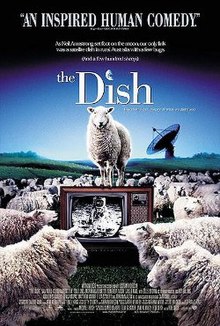The Dish
| The Dish | |
|---|---|

Promotional poster
|
|
| Directed by | Rob Sitch |
| Produced by | Santo Cilauro Tom Gleisner Michael Hirsh Jane Kennedy Rob Sitch |
| Written by |
Santo Cilauro Tom Gleisner Jane Kennedy Rob Sitch |
| Starring |
Sam Neill Kevin Harrington Tom Long Patrick Warburton |
| Music by | Edmund Choi |
| Edited by | Jill Bilcock |
| Distributed by |
Roadshow Entertainment (AUS) Warner Bros. (United States & Canada) Icon Entertainment International (UK) |
|
Release date
|
Toronto International Film Festival 15 September 2000 Australia 19 October 2000 |
|
Running time
|
101 minutes |
| Country | Australia |
| Language | English, Japanese |
The Dish is a 2000 Australian film that tells a somewhat fictionalised story of the Parkes Observatory's role in relaying live television of man's first steps on the Moon during the Apollo 11 mission in 1969. It was the top grossing film in Australia in 2000.
The radio telescope at Parkes (Parkes Observatory), New South Wales, Australia, was used by NASA throughout the Apollo program to receive signals in the Southern Hemisphere, along with the NASA Honeysuckle Creek Tracking Station near Canberra.
In the days before the July 1969 space mission that marked mankind's first steps on the Moon, NASA was working with a group of Australian technicians who had agreed to engineer a space-to-earth interface to carry the video and telemetry signals from the Lunar Lander on the Moon and relay them to the rest of the global audience, estimated then at some 600 million people. The actual dish antenna used had to be large as the signals expected from the spacecraft were very weak and easily lost. NASA had to use the Parkes radio telescope situated in the middle of an Australian sheep farm. There were some background concerns at NASA about using the Parkes antenna, mainly technical, as the signals had to go via point to point microwave links to get re-transmitted globally.
Based on a true story, "The Dish" takes a sometimes comical look at the differing cultural attitudes between Australia and the U.S. while revisiting one of the greatest events in history. It depicts the activities in a control room of a radio telescope doing a job it was not originally expected to do, but in the end did very well. The directors of the film portray, quite accurately, what is in essence, a complex technical task, such as re-pointing the dish when it loses the signal's "lock" and deciding to use it when the wind whips up threatening to damage the structure. The film dramatises the team-work of a few technicians, who sometimes nearly lose their cool with each other, painted against a backdrop of proud Australian townfolk, with visiting dignitaries hoping nothing will go wrong at the crucial moment.
...
Wikipedia
